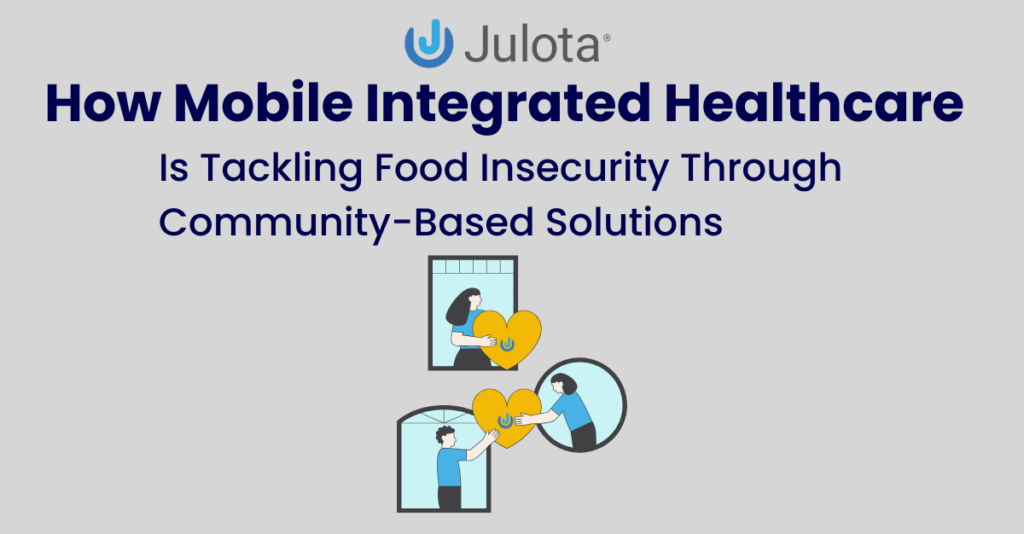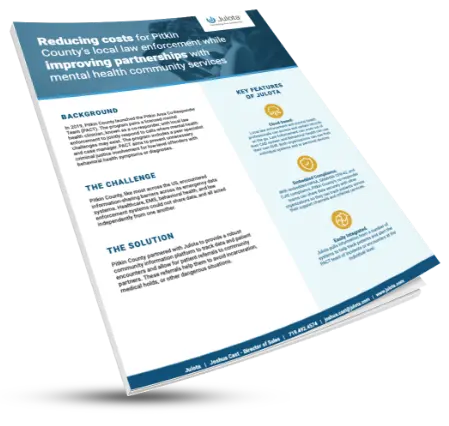Food insecurity is more prevalent than people realize. In 2022, over 17 million people in the United States were classified as food insecure, with as many as 6 million people being classified as very food insecure. Mobile Integrated Healthcare recognizes this crisis and is working to correct it. How?
Mobile Integrated Healthcare (MIH) tackles lack of food by actively reaching out to those who may suffer and offering help by reducing medical expenses, connecting people with helpful resources, organizing community events, and supporting local food banks and community gardens. Food insecurity can happen for many reasons. MIH takes a holistic approach to finding real solutions.

Food Insecurity and the Ways that Mobile Integrated Health Can Help
Food insecurity is a complex issue. Mobile Integrated Health recognizes that, more than just dropping off resources at someone’s doorstep, the solution to food insecurity lies in addressing the root issues. This often requires that MIH teams go to people, assess their situation, and provide a unique pathway to food security.
Depending on your area, some systems might work, and some may not. Below, we will outline several strategies MIH teams may use to overcoming a lack of food and prevent people from falling into hunger.
A quick note about the difference between hunger and food insecurity. Food insecurity refers to people who may have times during the year concerned about their ability to provide food for household members. Food insecure homes may eat only a limited amount of food and may not receive the range of nutrition required.
However, this is different from hunger. Hunger refers to someone experiencing adverse physical effects of an involuntary lack of food. Hunger is what happens to a household when they are food insecure for too long, and then their situation becomes even worse. MIH teams fight food scarcity to prevent hunger.
Here are the ways mobile integrated healthcare tackles food insecurity:
- Connecting Those Experiencing Food Insecurity with Resources
- Reducing the Cost of Other Healthcare Needs
- Providing Private Help and Bringing Food Directly to Those in Need
- Organizing Community Food Drive Events to Reduce Food Insecurity and Hunger
- Set up Co-ops and Supporting Food Banks (Community Gardens)
- Recognizing Those Who May Be Struggling with Food Insecurity
Now, we’ll dive into the depths of each of these strategies. Let’s begin.
Connecting Those Experiencing Food Insecurity with Resources
We’ve written about it before, but among the saddest things in this world is for a problem and a solution to be strangers. Too often, even in this modern age, people struggling with something are unaware of the steps they could take to correct the problem.
One of the first ways any Mobile Integrated Healthcare Team will work to combat a problem is to ensure that anyone who is struggling with food insecurity knows about the potential solutions. We will talk about the specific solutions in later sections, but the point is this: you can have all the solutions in the world, but if people don’t know they exist, it doesn’t do any good.
Mobile Integrated Health’s first job in combating food insecurity is to broadcast the solutions to every corner of a city. What are those solutions? Let’s talk about them.
Reducing the Cost of Other Healthcare Needs
Food is expensive, especially these days; however, the direct expense of food may not always be why someone faces food insecurity. People often skimp on their ability to buy food because they choose to purchase something else, such as healthcare.
This choice between food and healthcare is a terrible position for anyone. Nobody should have to decide whether they will have a good meal or pay for their medications. But that is a reality for many members of society.
Mobile Integrated Health teams work to correct food insecurity by reducing the financial strain on health. For example, if a community paramedic can connect a person with a cheaper medication solution, they may have more in the budget for food.
Further, mobile integrated health teams and community paramedics can remove the burden of travel that strains a person’s budget. By traveling directly to their homes (instead of making people pay for transportation to their appointments), they give people a little more in their bank accounts, hopefully leading to a bit of food security.
This is an example of how indirectly helping with food insecurity can make a big difference in a person’s life.
Providing Private Help and Bringing Food Directly to Those in Need
Many people who face financial struggles are afraid to talk about them. Some don’t want to face social stigmatization for “struggling,” and others are simply unsure who they would speak to (or don’t have anyone they can confide in).
Mobile Integrated Healthcare teams can look at city data and decide where their efforts to reduce food insecurity are most needed (also known as a needs assessment). Then they can contact these people, letting them know that resources are available.
One of the key facets of this approach is that Mobile Integrated Health teams assure people that they will keep their situation private, helping them quietly find freedom from food insecurity.
Sometimes, MIH teams will coordinate food delivered directly to these people. An example is the food program for seniors, Meals on Wheels. MIH teams can address the patient’s needs and then help them form a connection with these teams.
Organizing Community Food Drive Events to Reduce Food Insecurity and Hunger
Mobile Integrated Health teams will also help organize food drives and encourage participation in community events to prevent hunger. MIH is in a unique position when it participates in these events. Why?
They can direct people toward the events and use these events to connect with people who may also need medical, mental, and social help.
MIH-Community paramedic programs don’t just provide medical assessments and care. They can also connect people with social workers, provide direct mental healthcare in the field, and even combat substance abuse.
Setting Up Co-ops and Supporting Food Banks
Another resource that Mobile Integrated Health teams can help deliver is access to food co-ops, food banks, and community gardens. These are all ways of combating food insecurity.
Food co-ops often give people access to lower-priced or free food while providing a strong safety net for the community. Community gardens allow people access to fresh produce at various times during the year and are a valuable resource for those struggling with food insecurity.
Finally, MIH teams can show people the location of food banks and where, if needed, they can access food that has been donated, giving them an additional layer of security.
Recognizing Those Who May Be Struggling with Food Insecurity
As we mentioned in the beginning, many people struggling with food insecurity are reluctant to say anything. One way MIH teams can help is by providing routine screenings for their patients to ensure they don’t meet any risk factors for hunger.
The thing is, MIH teams go into places that providers don’t. They are in people’s homes, finding them on the street, and often finding them in vulnerable situations. MIH teams are uniquely positioned to reach out to the people, ensuring that nobody goes without food.
Part of the ways the MIH can combat the issue of food insecurity is by coordinating efforts with other members of the community: this means the fire department, law enforcement, EMS, and the ER.
Suppose these different teams can create a central reporting protocol, where anyone suspected of food insecurity is scheduled for a follow-up assessment. In that case, communities can take a big step toward ensuring no one is left behind.
Final Words: How MIH Combats Food Insecurity to Help People Thrive
Mobile Integrated Healthcare combats food insecurity in communities around the country in the hope of eliminating hunger and building healthier, happier cities. Food insecurity is a much bigger issue than most people think, with millions affected each year.
Community paramedics working within MIH teams will go into patient homes and provide assessments, determining those needing assistance. MIH teams work to cut costs, connect people with food services, and reduce the burden of travel in attaining food.
All this is possible only if there is a united community response. Contact Julota now to uncover how their platform connects members to the community resources to create a safety blanket that reduces food insecurity.
Author
-

Noah Weinberg is a Marketing Associate at Julota, where he focuses on elevating the alternative response space, specifically Mobile Integrated Healthcare (MIH), Community Paramedicine, and co-responder models. He writes about the intersection of law enforcement, healthcare, and community well-being, drawing on real-world experiences with community paramedicine programs in Ontario, Canada.




